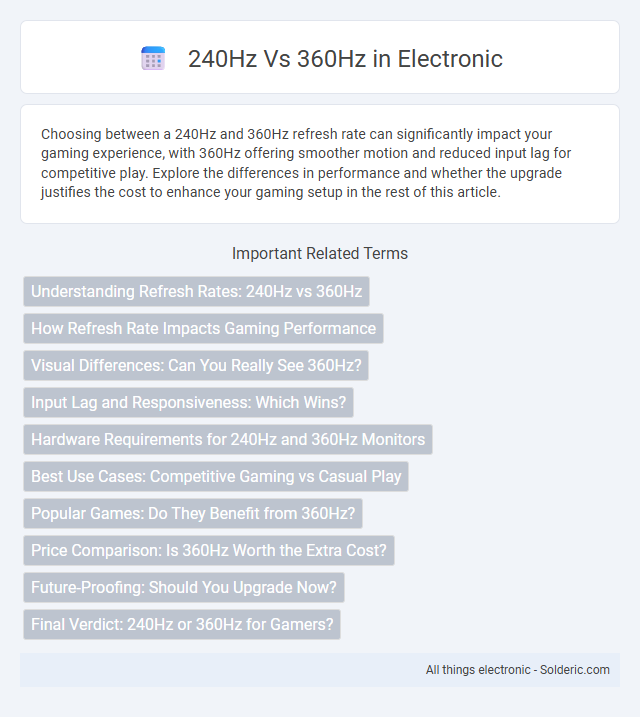Choosing between a 240Hz and 360Hz refresh rate can significantly impact your gaming experience, with 360Hz offering smoother motion and reduced input lag for competitive play. Explore the differences in performance and whether the upgrade justifies the cost to enhance your gaming setup in the rest of this article.
Comparison Table
| Feature | 240Hz | 360Hz |
|---|---|---|
| Refresh Rate | 240 times per second | 360 times per second |
| Smoothness | Very smooth motion | Extremely smooth motion |
| Input Lag | Low latency (approx. 4ms) | Ultra-low latency (approx. 2.7ms) |
| Motion Clarity | Clear motion with minimal blur | Sharper motion clarity, near motion blur elimination |
| Hardware Demands | High-end GPU required for max performance | Top-tier GPU required for consistent 360fps output |
| Use Case | Competitive gaming, esports | Professional esports, elite gaming setups |
| Price Range | Moderate to high | Premium pricing |
| Availability | Widely available | Limited models, niche market |
Understanding Refresh Rates: 240Hz vs 360Hz
A 240Hz refresh rate delivers 240 frames per second, providing smoother motion and reduced motion blur ideal for gaming and fast-paced content. Increasing to 360Hz offers even higher frame updates, resulting in ultra-fluid visuals and enhanced responsiveness, particularly beneficial for competitive gamers seeking minimal input lag. Your experience improves with 360Hz if your hardware supports it, but the perceptible difference depends on the type of content and your display capabilities.
How Refresh Rate Impacts Gaming Performance
A 360Hz refresh rate offers smoother and more responsive gameplay compared to 240Hz, providing up to 50% more frames per second that can significantly reduce motion blur and input lag. This higher refresh rate enhances reaction times and precision in fast-paced competitive games such as first-person shooters and racing titles. Gamers using 360Hz displays gain a noticeable advantage in visual fluidity and target tracking, particularly when paired with high-end GPUs capable of consistently outputting matching frame rates.
Visual Differences: Can You Really See 360Hz?
The jump from 240Hz to 360Hz offers a noticeable improvement in smoothness and motion clarity, especially in fast-paced gaming scenarios where every millisecond counts. While 240Hz already delivers a highly fluid visual experience, 360Hz reduces motion blur further and enhances the responsiveness, making it easier for gamers to track rapid movements and react swiftly. However, the perceptible difference depends on factors like display quality, game type, and individual visual acuity, with only competitive players often benefiting significantly from the ultra-high 360Hz refresh rate.
Input Lag and Responsiveness: Which Wins?
A 360Hz monitor offers significantly lower input lag and faster responsiveness compared to a 240Hz display, making it ideal for competitive gaming where every millisecond counts. Higher refresh rates reduce motion blur and improve frame delivery, directly impacting your reaction time and overall performance. For gamers seeking the ultimate edge in precision and speed, a 360Hz panel delivers superior responsiveness over a 240Hz option.
Hardware Requirements for 240Hz and 360Hz Monitors
240Hz monitors require a powerful GPU capable of consistently pushing high frame rates, typically found in mid-to-high-end gaming setups, while 360Hz monitors demand even more advanced hardware like top-tier GPUs and CPUs to fully utilize the increased refresh rate. Your system's performance must include a combination of fast processors and efficient cooling solutions to avoid bottlenecks at 360Hz. Ensuring compatibility with DisplayPort 1.4 or HDMI 2.1 interfaces is also crucial for stable high refresh rate output across both monitor types.
Best Use Cases: Competitive Gaming vs Casual Play
240Hz monitors provide a smooth and responsive experience ideal for casual players seeking improved visuals and fluid gameplay without the high cost. 360Hz monitors deliver ultra-fast refresh rates necessary for competitive gaming, allowing you to react quicker and gain a crucial edge in fast-paced esports titles. Choosing between 240Hz and 360Hz depends on your gaming priorities, with 360Hz best suited for professional-level performance and 240Hz perfect for everyday entertainment.
Popular Games: Do They Benefit from 360Hz?
Popular competitive games like CS:GO, Valorant, and Overwatch show marginal benefits at 360Hz compared to 240Hz due to their fast-paced nature and high frame rates. While 360Hz monitors can deliver slightly smoother motion and quicker response times, most players may not perceive a significant advantage over 240Hz displays in typical gameplay. Your choice between 240Hz and 360Hz should consider the hardware capabilities and whether you play at high competitive levels where every millisecond counts.
Price Comparison: Is 360Hz Worth the Extra Cost?
360Hz monitors typically cost 30-50% more than 240Hz models, reflecting advanced technology and smoother motion clarity. Competitive gamers and esports professionals may find the extra expense justified due to the higher refresh rate's potential to enhance reaction times and in-game precision. Casual users and budget-conscious buyers often gain minimal perceptible benefit, making 240Hz the more cost-effective choice for most gaming needs.
Future-Proofing: Should You Upgrade Now?
Upgrading from 240Hz to 360Hz offers a marginal improvement in refresh rates, catering primarily to competitive esports players seeking ultra-responsive gameplay. The 360Hz monitors provide smoother motion clarity and reduced input lag, but current graphics hardware must consistently deliver high frame rates above 240fps to fully utilize this advantage. For most users, investing in a 240Hz monitor remains a balanced choice, while adopting 360Hz technology can future-proof setups as software and hardware evolve to support higher frame rates.
Final Verdict: 240Hz or 360Hz for Gamers?
Choosing between 240Hz and 360Hz refresh rates depends on your gaming setup and preferences. A 360Hz monitor offers smoother motion and reduced input lag, benefiting competitive esports players who need ultra-fast response times. For most gamers, a 240Hz display delivers excellent performance and visual clarity without the higher cost associated with 360Hz panels.
240Hz vs 360Hz Infographic

 solderic.com
solderic.com